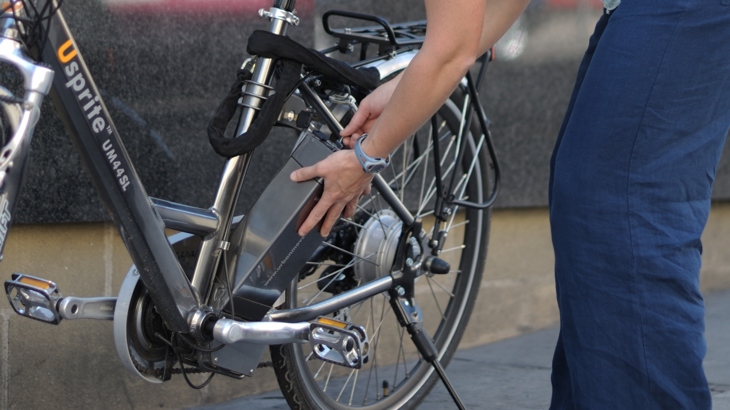With more of us opting for electric-powered pedalling, it’s important to know how to look after your e-bike. This includes maintaining your battery. Electric bikes expert Richard Peace shares his tips on how to get the maximum possible range out of yours.

E-bikes are a great way of getting around actively and sustainably, but it's important to look after your battery.
The UK’s Bicycle Association reported that 160,000 electric bikes were sold in the UK in 2020, compared to 108,000 electric car sales over the same period.
This e-bike boom doesn’t look like it will be letting up any time soon.
In fact, many e-bike brands have been reporting double or triple-digit year on year growth.
At the same time, new car registrations have stagnated over recent years.
This has led some pundits to speculate that e-bike sales could outsell cars in the not too distant future, unlikely as that may seem today.
When it comes to owning an e-bike, its battery is the single most expensive ‘consumable’ likely to need replacing at some point.
This guide will help you look after your e-bike battery, whether you're commuting or cycling for leisure.
- What are e-bike batteries?
- What are they made of?
- Where should my e-bike battery sit on my bike?
- How much do e-bike batteries weigh, and what size do I need?
- How far will I go on a charge?
- How long will my battery last and what guarantee should I get?
- Battery charging tips
- Care and maintenance tips.

E-bikes are great for both leisurely cycles as well as commuting. ⒸBosch eBike Systems
What are e-bike batteries?
An electric bike battery is a battery pack found mounted on the bike.
You'll also find many electric bikes these days with batteries integrated into the bike's frame.
They are often locked onto the bike for security whilst parked, and a key usually allows you to remove yours for charging.
A few models of e-bike however do not allow the battery to be removed.
Just about all models of electric bikes allow the battery to be charged on the bike, whether it is removable or not.
What are they made of?
The earliest e-bikes featured heavy lead-acid, nickel-cadmium and nickel-metal hydride batteries.
Modern e-bikes sold in the UK use lithium-ion batteries, which give much more power per kilogram of battery weight.
Batteries are made up of cells, and these cells are one of the main component parts of an e-bike battery.
Where should my e-bike battery sit on my bike?
The most common mounting positions are on a rear rack, on the downtube, or totally integrated into the frame.
The rear rack option is okay for lighter batteries on lightly-loaded bikes intended for more gentle riding.
This can start to affect handling though, especially at speed on corners or if you have loaded panniers.
Downtube-mounted batteries are still very common and mean a better-balanced electric bike.
It’s always good to keep the weight of the battery and motor low down and central to help bike handling.
These other designs are slowly being replaced by frame-integrated batteries, which are also good for balance.
You may find some e-bike retrofit kits which put the battery on the handlebars.
This is fine if it’s a small, light battery, but bigger ones may affect handling.

Batteries can be mounted on an e-bike in many places, including the seat tube as shown here.
How much do e-bike batteries weigh, and what size do I need?
Battery capacity is measured in Watt-hours (Wh).
Most batteries currently found on new e-bikes will hold between 200Wh and 625Wh.
The maximum capacity creeps up as new models are announced year after year.
There are even dual battery 1250Wh systems for those mammoth days in the saddle.
Batteries will usually weigh between 650g and 1kg for every 100Wh of capacity.
Small batteries are used by lighter designs of e-bike and can bring the weight of some bikes down to around 15kg.
You may even find some expensive electric road racing models that are even lighter.
Choosing a lighter e-bike with a smaller battery may be useful in several situations, such as if you have to carry your e-bike up sets of stairs.
If you’re a train commuter with an electric folding bike then a light bike will also be much easier to carry on and off your carriage.
And of course, in situations where you run out of battery or want to turn your power off, it’s useful to have a light bike to pedal on.
Small batteries are also cheaper to replace, but the obvious downside is that your range will be less.
Conversely, very large batteries of 600Wh will allow you to ride for many hours without needing a recharge.
As you’d expect, these do come with extra weight and cost, should you need to replace them.
Charging times from empty to full vary, but can be anything from around 1.5 hours for smaller capacity batteries to 5 hours plus for very large ones.
How far will I go on a charge?
It depends! A simple method of calculation is to divide the Wh capacity of a battery by 15.
This gives a very rough estimate of the range in miles.
For example, you should be able to ride about 33 miles on a 500Wh battery.
But there are so many other factors affecting range.
These include the weight of the rider, their fitness level, the weather conditions on the day, and the type of terrain they’re crossing.
It’s best to consider the type of riding you plan to do to work out what capacity battery you’ll need.
Bosch eBike Systems has a great tool for calculating the range their motors and batteries will provide.
How long will my battery last and what guarantee should I get?
The short answer is several years, as long as you look after the battery well.
The quality of the battery in this first place is important – a well-made cell pack is less likely to fail than a poorer one.
Replacement cost is one indicator of likely build quality and longevity.
For example, one budget e-bike maker is currently selling a 480Wh battery for £189.
In contrast, the market leader in the high-quality sector, Bosch eBike Systems, produces a 500Wh pack that currently retails for nearly three times as much.
The guarantee you receive is also a big clue as to the quality and likely longevity.
Perhaps the best guarantee out there is from Shimano.
Their e-bike batteries are guaranteed by charge cycles (full charges).
They guarantee that at least 60% of the battery’s capacity will remain after 1000 charge cycles.
This doesn’t mean your battery will pack up after 1000 charges - around eight to nine years is a typical lifespan you see quoted for Bosch or Shimano batteries.
The budget battery mentioned above carries a one-year guarantee and only against total failure, not loss of capacity.

When choosing an e-bike and battery, t's important to consider what sort of cycling you'll be doing.
Battery charging tips
As mentioned already, electric bike batteries do naturally degrade very slowly.
However, charge it correctly and you’ll get the most possible miles out of it.
To maximise the life of your battery, follow these tips.
Recharge the battery to a high level after every ride
Disconnect the charger once it’s been topped up.
It’s important to not leave the battery on charge overnight when it can’t be actively monitored.
If you have a cheaper e-bike battery, one trick to prolong battery life is to disconnect it when it’s not quite fully charged.
This is because its battery management system (BMS) may not be as good, and maybe more likely to overcharge the battery.
Virtually all e-bike batteries contain a BMS.
This acts to protect the health of the battery cells when in use, so they are not overcharged and stay within their optimum voltage, avoiding damage.
Always use the approved charger
Smart chargers ‘talk’ electronically to the BMS and cut off power at full charge capacity.
A charger not specifically made for that battery risks damage through overcharging or charging too quickly.
Don’t leave the battery empty or near empty
The BMS can switch the battery into ‘sleep’ mode if the voltage drops too low.
This might happen if you leave a battery nearly empty for months or years.
The BMS draws a small current to keep operating, which will flatten a nearly empty battery.
Once in sleep mode, it may be difficult to ‘wake’ the battery up again as the voltage has dropped so low the BMS thinks there might be a safety problem (even though that’s unlikely).
Keeping the battery in a moderate to high state of charge when in regular use means this will not happen.
Follow the manufacturer's advice when storing an e-bike battery
Battery manufacturers have a recommended level of charge for long term storage and it’s important to follow this.
For example, Bosch recommends a charge level of 30-60% charge (two or three of the five LED charge capacity indicator lights present on all of their batteries).
And again, store away from direct heat and at room temperature. If the storage location has a smoke detector, store it near that for extra safety.

E-bike technology is transforming how we travel, such as with cargo bike deliveries. ⒸBosch eBike Systems
Care and maintenance tips
Aside from charging properly, there are lots more things you can do to take care of your battery.
Follow these tips to prevent damage to your battery.
Avoid extremes of temperature
This means charging your battery indoors when it’s cold and keeping it inside until needed for your ride.
Very cold weather can affect your battery’s range, particularly if it’s left in low temperatures for a long time.
It’s even more important to avoid very hot temperatures.
Sitting a battery in the sun directly or even just in an enclosed, unventilated space on a hot day is a bad idea.
Prolonged exposure to heat can cause older e-bike batteries to catch fire, although this is an extremely rare occurrence.
Modern lithium batteries have all sorts of safeguards built into them, making this even less likely to happen.
Be gentle with your battery
Vibration and shock to a battery through rough treatment are not a good idea.
Along with extremes of temperature, this is an area to pay special attention to.
Damaged cells plus extreme temperatures is a recipe for failure of one or more cells.
Be wary of cheap ‘high performance’ batteries
Cheaper batteries with high claims for battery life and the number of charge cycles should be regarded with suspicion.
These models may push battery performance to the max, leading to failure more quickly than you would expect.
At the other end of the scale, manufacturers of premium quality e-bike batteries may attain so-called UL certification.
This new voluntary testing standard looks at the quality of all the electrical components on pedal-assist bikes.
Named UL 2849 to be precise, it’s already been endorsed by Bosch, Panasonic and Trek.
It’s not a necessity for a good e-bike battery, but if your battery is UL-certified then it’s certainly a big plus.
Don’t use a pressure washer near your e-bike battery
The best electric bikes can be ridden in heavy rain and even ford streams.
However, they are not specifically protected against pressurised water.
Cleaning an e-bike with a pressure washer is a very bad idea, especially getting pressurised water near electrical connection areas and batteries.
Keep electrical connections clean
Saltwater is so corrosive that it can lead to short circuits.
If you ride regularly on wet, salted roads in winter, you should clean your electrical contact points, the battery’s mounting point, and your bike in general.
If you get dirt in the contacts, clean them with a small soft brush and consider using electrical contact cleaner spray.





